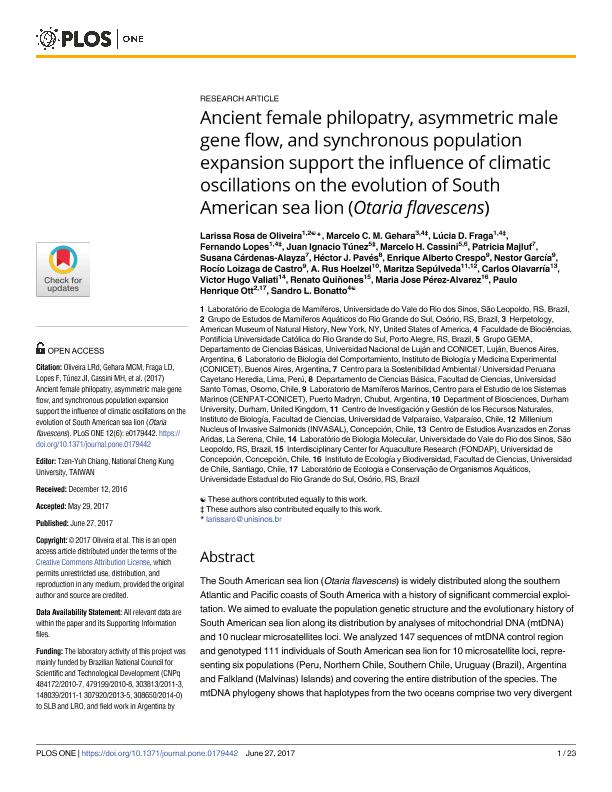Artículo
Ancient female philopatry, asymmetric male gene flow, and synchronous population expansion support the influence of climatic oscillations on the evolution of South American sea lion (Otaria flavescens)
Rosa de Oliveira, Larissa; Gehara, Marcelo C. M.; Fraga, Lúcia D.; Lopes, Fernando; Tunez, Juan Ignacio ; Cassini, Marcelo Hernan
; Cassini, Marcelo Hernan ; Majluf, Patricia; Cárdenas Alayza, Susana; Pavés, Héctor J.; Crespo, Enrique Alberto
; Majluf, Patricia; Cárdenas Alayza, Susana; Pavés, Héctor J.; Crespo, Enrique Alberto ; Garcia, Nestor Anibal
; Garcia, Nestor Anibal ; Loizaga de Castro, Rocio
; Loizaga de Castro, Rocio ; Hoelzel, A. Rus; Sepúlveda, Maritza; Olavarría, Carlos; Valiati, Victor Hugo; Quiñones, Renato; Pérez Alvarez, Maria Jose; Ott, Paulo Henrique; Bonatto, Sandro Luis
; Hoelzel, A. Rus; Sepúlveda, Maritza; Olavarría, Carlos; Valiati, Victor Hugo; Quiñones, Renato; Pérez Alvarez, Maria Jose; Ott, Paulo Henrique; Bonatto, Sandro Luis
 ; Cassini, Marcelo Hernan
; Cassini, Marcelo Hernan ; Majluf, Patricia; Cárdenas Alayza, Susana; Pavés, Héctor J.; Crespo, Enrique Alberto
; Majluf, Patricia; Cárdenas Alayza, Susana; Pavés, Héctor J.; Crespo, Enrique Alberto ; Garcia, Nestor Anibal
; Garcia, Nestor Anibal ; Loizaga de Castro, Rocio
; Loizaga de Castro, Rocio ; Hoelzel, A. Rus; Sepúlveda, Maritza; Olavarría, Carlos; Valiati, Victor Hugo; Quiñones, Renato; Pérez Alvarez, Maria Jose; Ott, Paulo Henrique; Bonatto, Sandro Luis
; Hoelzel, A. Rus; Sepúlveda, Maritza; Olavarría, Carlos; Valiati, Victor Hugo; Quiñones, Renato; Pérez Alvarez, Maria Jose; Ott, Paulo Henrique; Bonatto, Sandro Luis
Fecha de publicación:
06/2017
Editorial:
Public Library of Science
Revista:
Plos One
ISSN:
1932-6203
Idioma:
Inglés
Tipo de recurso:
Artículo publicado
Clasificación temática:
Resumen
The South American sea lion (Otaria flavescens) is widely distributed along the southern Atlantic and Pacific coasts of South America with a history of significant commercial exploitation. We aimed to evaluate the population genetic structure and the evolutionary history of South American sea lion along its distribution by analyses of mitochondrial DNA (mtDNA) and 10 nuclear microsatellites loci. We analyzed 147 sequences of mtDNA control region and genotyped 111 individuals of South American sea lion for 10 microsatellite loci, representing six populations (Peru, Northern Chile, Southern Chile, Uruguay (Brazil), Argentina and Falkland (Malvinas) Islands) and covering the entire distribution of the species. The mtDNA phylogeny shows that haplotypes from the two oceans comprise two very divergent clades as observed in previous studies, suggesting a long period (>1 million years) of low inter-oceanic female gene flow. Bayesian analysis of bi-parental genetic diversity supports significant (but less pronounced than mitochondrial) genetic structure between Pacific and Atlantic populations, although also suggested some inter-oceanic gene flow mediated by males. Higher male migration rates were found in the intra-oceanic population comparisons, supporting very high female philopatry in the species. Demographic analyses showed that populations from both oceans went through a large population expansion ~10,000 years ago, suggesting a very similar influence of historical environmental factors, such as the last glacial cycle, on both regions. Our results support the proposition that the Pacific and Atlantic populations of the South American sea lion should be considered distinct evolutionarily significant units, with at least two managements units in each ocean.
Palabras clave:
Pinnipedos
,
Molecular Markers
,
Female Philopatry
,
Phylogeography
Archivos asociados
Licencia
Identificadores
Colecciones
Articulos(CESIMAR)
Articulos de CENTRO PARA EL ESTUDIO DE SISTEMAS MARINOS
Articulos de CENTRO PARA EL ESTUDIO DE SISTEMAS MARINOS
Articulos(OCA PQUE. CENTENARIO)
Articulos de OFICINA DE COORDINACION ADMINISTRATIVA PQUE. CENTENARIO
Articulos de OFICINA DE COORDINACION ADMINISTRATIVA PQUE. CENTENARIO
Citación
Rosa de Oliveira, Larissa; Gehara, Marcelo C. M.; Fraga, Lúcia D.; Lopes, Fernando; Tunez, Juan Ignacio; et al.; Ancient female philopatry, asymmetric male gene flow, and synchronous population expansion support the influence of climatic oscillations on the evolution of South American sea lion (Otaria flavescens); Public Library of Science; Plos One; 12; 6; 6-2017; e0179442
Compartir
Altmétricas



